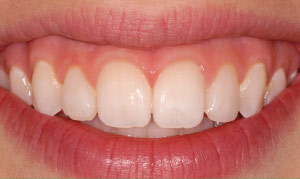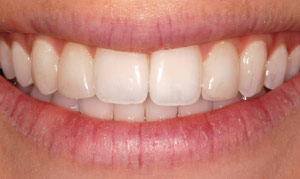Gummy Smiles
Correct diagnosis is key to solving a complex cosmetic concern
(Continued)
The Influence of the Lip
The act of smiling involves many of the muscles used in facial expression, especially those that retract the lips to reveal the teeth and gums. The average lip moves 6-8 millimeters (mm) from its normal resting position to a full smile. If the lip is hypermobile, meaning it rises way up, too much gum tissue may be revealed in the smile.
There are a number of ways to modify the action of those muscles, ranging from Botox shots to temporarily paralyze them (treatment generally needs to be repeated every six months as the Botox wears off), to repositioning the muscle attachments to prevent excessive movement.
A surgery to restrict how high the lip can move can make dramatic changes. Usually performed by a periodontist (a dentist who specializes in the supporting structures of the teeth), an oral surgeon, or a plastic surgeon, the major advantage of this treatment is that it is permanent.
A person may have normal lip movement but just a short upper lip and therefore display more gum tissue than desired. Modifying the movement of the lip will not help this group of people because the degree of movement is not the cause for the excess display of gum tissue.
A Long Upper Jaw
 |
| Vertical Maxillary (upper jaw) Excess is often treated with orthognathic surgery. |
 |
| The maxilla is reduced in size diminishing the amount of gum tissue displayed. |
| Dentistry by Dr. Elizabeth M. Bakeman |
When the proportionality of the tooth and gum tissue complex is normal, but there is still too much gum tissue showing, the cause may be that the upper jaw is too long for the face. This is referred to as Vertical Maxillary Excess because the upper jaw (maxilla) is excessively long relative to the base of the skull to which it is attached.
Treatment for this condition may include orthognathic surgery (“ortho” – straighten; “gnathos” – jaw), by which the upper jaw is surgically positioned upward in order to diminish the amount of tooth and gumminess showing in the smile.
If the teeth themselves (as opposed to the jaw bone) hang down too much, they can sometimes be moved up orthodontically to make them less prominent.
A Strategy For Success
Gummy smiles exist for a variety of reasons and proper diagnosis is critical. There is often a combination of factors that create the effect of gumminess. There may also be a variety of ways to treat a gummy smile. But it's important not to make the treatment worse than the problem. That's why the correct identification of what's causing the problem is so important. Often a team, including dental specialists, will work together on a strategy to create a smile beautifully suited to your personality and emotional well-being.




